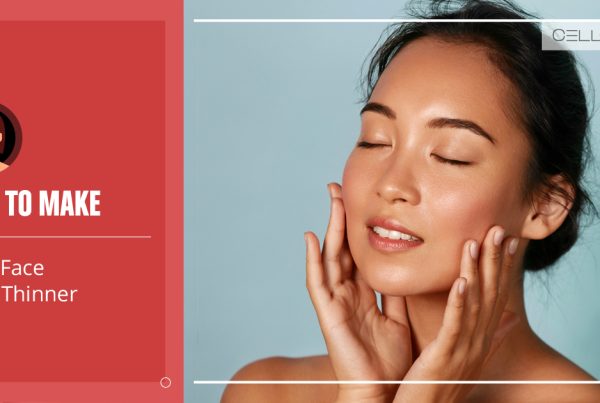Published on: April 9, 2020 | Updated on: August 29, 2024

Facial symmetry, or having a balanced appearance on one’s face, often has the effect of making a person look emotionally balanced and happy. Having traits that don’t perfectly mirror one another on both sides of the face is called asymmetry.
Almost everyone has some degree of asymmetry on their face. But some cases of asymmetry are more noticeable than others. Injury, aging, smoking, and other factors can contribute to asymmetry. When one side of the face is considerably smaller than the other, a person may find that the muscles of the face are weaker on that side.
What Causes a Person to Develop an Asymmetrical Face?
- Genetics – sometimes an asymmetrical face is just the result of development and genetics. Cleft lip and palate and vascular disorders are genetic health conditions that are potential causes for asymmetrical features.
- Sun Damage – as a person ages, exposure to UV rays can cause spots, patches, and moles to develop on the skin. Sun damage is rarely distributed evenly over the whole face, especially if spending time outside wearing a baseball hat, work outside, or spend a lot of time driving. Sun damage can cause damage to one side or one area of the face.
- Smoking – because smoking exposes the face to toxins, it makes sense that smoking has been connected to facial asymmetry.
- Dental Work – having a tooth extracted can change the way the muscles in the face appear. Using dentures or getting dental veneers can also change the contours of the face. The result isn’t always symmetrical.
- Aging – as people get older, facial asymmetry increases. This is a natural part of aging. Although the bones stop growing at puberty, the cartilage continues to grow as we age. This means the ears and nose grow and change as we age, which may cause asymmetry.
- Lifestyle Habits – some people believe that sleeping on the stomach or with the face against a pillow, sitting with the legs crossed in the same direction for long periods of time, having poor posture, and resting the face against a hand can all contribute to facial asymmetry.
- Injury – trauma or injury to the face during childhood or in adulthood can cause asymmetry. Injuries like a broken nose or a deep cut can cause the face to appear asymmetrical.
- Bell’s Palsy – sudden facial asymmetry is a sign of a more serious condition. Bell’s palsy is a paralysis of facial nerves, causing a new or sudden onset of weakness in the muscles on one side of the face. Bell’s palsy can occur after pregnancy or a viral infection, and it’s most often temporary. Bell’s palsy facial asymmetry is caused by the muscles in one side of the face being less able or unable to move.
- Stroke – facial drooping is a sign of a stroke. If a person’s smile is suddenly uneven or they experience numbness on one side of the face they should seek immediate medical care. Other symptoms of a stroke include arm numbness or weakness and difficulty speaking.
- Torticollis – also called “twisted neck,” torticollis refers to abnormal positioning of the neck muscles. Sometimes torticollis happens while in the womb, resulting in some facial asymmetry from birth. Eye weaknesses can cause a person to tilt or twist the neck in different ways to see better, resulting in the muscles growing stronger on one side of the neck than the other. Many cases of torticollis are temporary and the signs resolve. Less commonly it can be permanent.
How to Correct an Asymmetrical Face
Facial asymmetry can make a face seem unnatural. There are a few ways to make a face more symmetrical but only one true way is non-invasive; facial exercises. These can be done alone and in the comfort of one’s home. Facial exercises can help obtain a symmetrical smile.
The facial exercise consists of making repetitive motions and exaggerated expressions in order to activate and build muscles. Consider it resistance training for the face. By strengthening the matrix that holds everything up, sagging around the jaw and eyes might be less likely over time. Facial aging is caused by a loss of elasticity, as well as by the gradual displacement of fat pads between muscle and skin, which tend to slide downward over time. The idea behind doing exercises is that by building up the muscle, the fat pads will be more prone to stay in place, making the face appear fuller and more youthful.
Facial Exercise for a Symmetrical Face
Partial Wink
This activity aligns the tissues of the lower eyes and upper cheek. It involves partial winking of an eye for 50 times. Hold each wink for a second. Then push the fingers into the skin of the temple. Slightly pull the skin back and close the eyes tightly while the fingers are still in position. About 20 repetitions of this workout at a time will be helpful.
Facial Stretch
Elongate the face while looking up and pull the tissues under the upper lip to cover the bottom lip. Smile widely with the face still in the elongated position. 20 repetitions of this exercise will refresh the skin and align the facial muscles for a more noticeable symmetrical face.
Cheek Toning
Facial asymmetry can make one side of the cheek smaller than the other. Such imbalance is easily noticeable. Press the upper cheek with three fingers from each hand. Use the fingers to push the muscles towards the jaw while smiling. Try to resist the pressure from the fingers by using the smile to manipulate the cheek tissues. Don’t move the head during the workout. Correcting the cheek alignment can make a smile symmetrical.
Facial Yoga Exercises
Facial yoga moves not only to increase circulation but also work the muscles that help tighten complexion. This allows a person to avoid the jowls and sagging skin that come over time, thanks to the basic effects of gravity, along with the atrophying of the facial muscles. Try some of the facial yoga moves listed below.
- Puff out the cheeks, push air into the mouth and move the air from one side to the other four times. Repeat up to 5 times a day to help raise the cheeks.
- Make the eyes wide, raise the eyebrows and stick out the tongue. Hold for up to 60 seconds and repeat up to ten times. This helps the neck and cheeks.
- Purse the mouth into a tight O. Then, smile and squint the eyes, without allowing the mouth to move. Repeat 10 times to help tighten skin overall.
- Clasp the hands to the face, and smile wide. Make sure the hands prevent the mouth from actually smiling. The idea is for the facial muscles to work against the hands. Repeat 10 times to help tighten the facial muscles.
Summary
Having an asymmetrical face is a common condition, as well as a treatable one. If a person is unhappy with having an unbalanced face, there are plenty of non-invasive techniques to correct the problem.
Muscles of one side of the face may be weaker than the other if the face isn’t well aligned. They can make the smile uneven. Facial workouts can restore balance to the tissues on the face and contribute to an asymmetrical face. Moreover, they will help to control the muscles.
A person can use their fingers to assist the movement of the weak muscles. Watching one’s reflection in a mirror while practicing the exercise will enable a correct performance.
Sources
Footnotes
- Rhodes G, Proffitt F, Grady JM, Sumich A. Facial symmetry and the perception of beauty. Psychonomic Bulletin & Review. 1998;5:659-69.
- Perrett DI, Burt DM, Penton-Voak IS, Lee KJ, Rowland DA, Edwards R. Symmetry and human facial attractiveness. Evolution and human behavior. 1999;20(5):295-307.
- Harun NA, Adam KB, Abdullah NA, Rusli N. Is a symmetrical face really attractive?. International Journal of Oral and Maxillofacial Surgery. 2023;52(6):703-9.
- Zaidel DW, Cohen JA. The face, beauty, and symmetry: perceiving asymmetry in beautiful faces. International Journal of Neuroscience. 2005;115(8):1165-73.
- Jackson TH, Mitroff SR, Clark K, Proffit WR, Lee JY, Nguyen TT. Face symmetry assessment abilities: Clinical implications for diagnosing asymmetry. American Journal of Orthodontics and Dentofacial Orthopedics. 2013;144(5):663-71.
- Pereira LM, Obara K, Dias JM, Menacho MO, Lavado EL, Cardoso JR. Facial exercise therapy for facial palsy: systematic review and meta-analysis. Clinical rehabilitation. 2011;25(7):649-58.
References
- Asymmetrical Face: What Is It, and Should You Be Concerned?. Healthline. Accessed 9/6/2023.
- What to know about having an asymmetrical face. Medical News Today. Accessed 9/6/2023.
- How To Make Your Face More Symmetrical Naturally – Top Tips. Face Yoga Method. Accessed 9/6/2023.
CELLAXYS does not offer Stem Cell Therapy as a cure for any medical condition. No statements or treatments presented by Cellaxys have been evaluated or approved by the Food and Drug Administration (FDA). This site contains no medical advice. All statements and opinions are provided for educational and informational purposes only.
Dr Pejman Bady
Author
Dr. Pejman Bady began his career over 20 years ago in Family/Emergency Medicine, working in fast-paced emergency departments in Nevada and Kansas. He has served the people of Las Vegas as a physician for over two decades. Throughout this time, he has been met with much acclaim and is now the head of Emergency Medical Services in Nye County, Nevada. More about the doctor on this page.
Dr Pouya Mohajer
Contributor
Pouya Mohajer, M.D. is the Director of Spine and Interventional Medicine for CELLAXYS: Age, Regenerative, and Interventional Medicine Centers. He has over 20 years of experience in pain management, perioperative medicine, and anesthesiology. Dr. Mohajer founded and is the Medical Director of Southern Nevada Pain Specialists and PRIMMED Clinics. He has dedicated his career to surgical innovation and scientific advancement. More about the doctor on this page.










